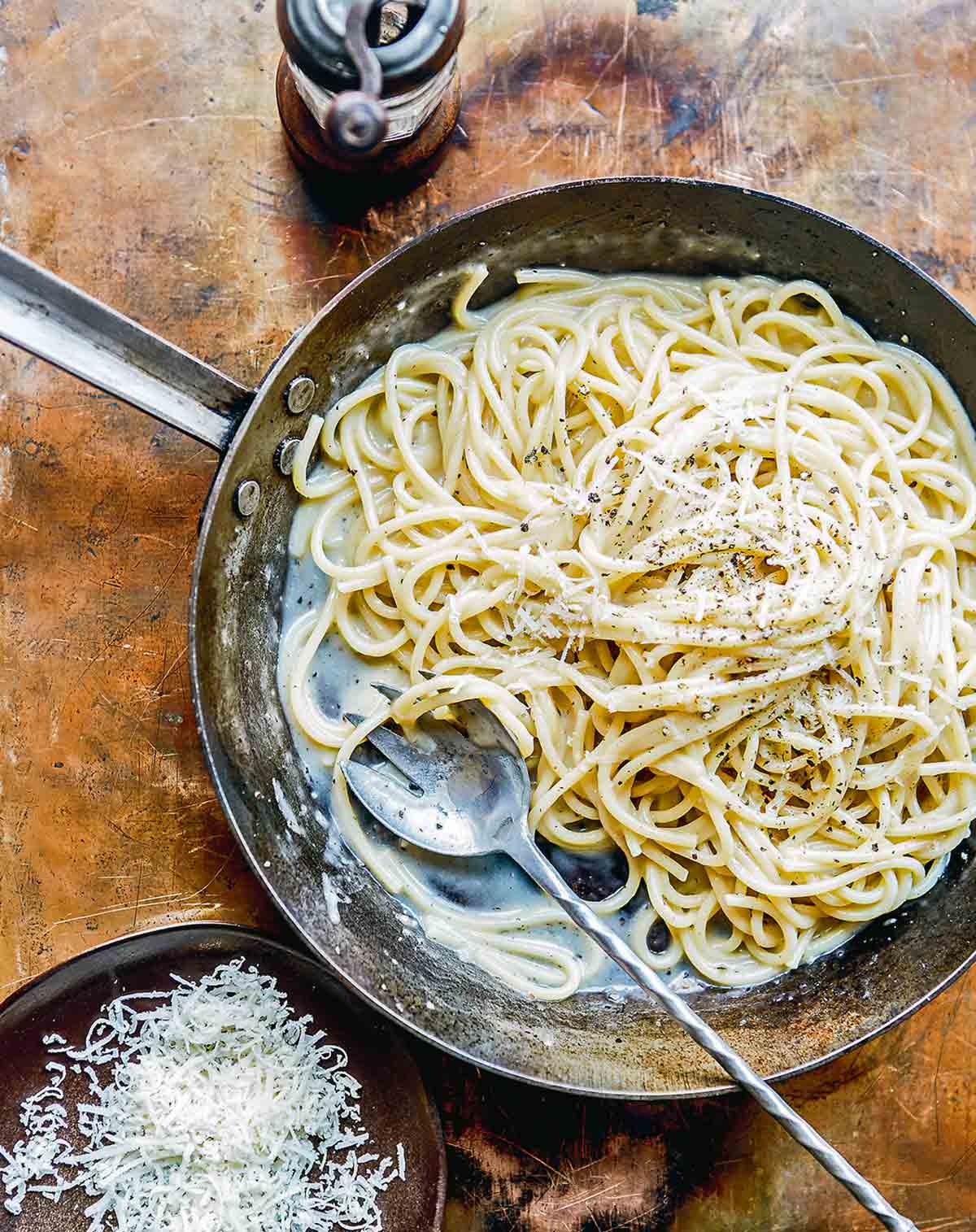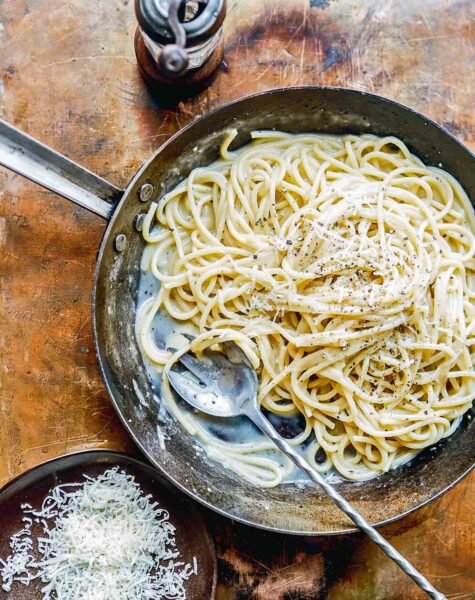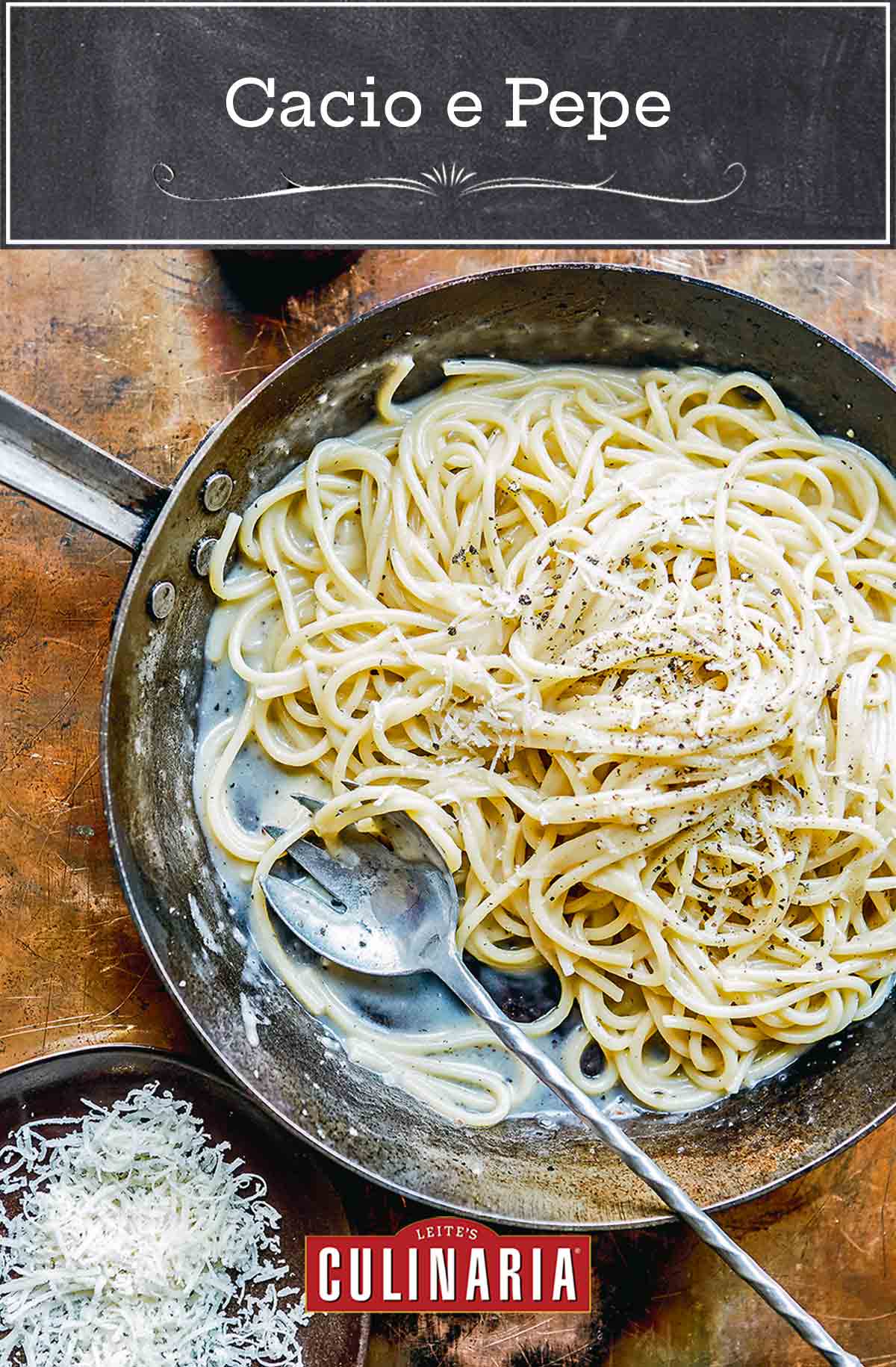
“There are many ways to make this classic dish of cacio e pepe and each Roman cook will show you some slightly different ways to manipulate pasta, cheese, and pepper into a wonderful, warm bowl of comfort food.” So begins this seemingly unassuming recipe for authentic cacio e pepe. But when you peruse the instructions, that’s when the magic truly begins.
The cacio e pepe pasta relies on a method known as “risotato,” so-called because it is like making a risotto. The pasta is cooked not in a pot of salted water but in a frying pan just large enough to contain the spaghetti. As the cooking water is absorbed by the pasta the liquid in the pan reduces and becomes the sauce. And that’s just in theory. Wait’ll you taste it.–David Leite
Cacio e Pepe FAQs
Yeah, we get tongue-tied sometimes, too. Here’s the phonetic pronunciation kaa·choh ee peh·pay And here’s an Italian speaking it for you.
This recipe specifically calls for cacio de Roma (literally Roman cheese). And since cacio de pepe is a quintessential Roman dish, you’d do well to find some. It’s a semi-soft sheep’s cheese from Lazio (the region of Italy that encompasses the province of Rome).
While a hard cheese won’t give you quite the same result, there are substitutions. Most of our testers were unable to find cacio de Roma without specially ordering it, so if you find yourself in the same situation, you can use pecorino Romano (a hard sheep’s milk cheese) instead. Failing that, Parmigiano-Reggiano makes an acceptable choice as well
Although it’s not traditional, our testers had success making this with linguine, bucatini, penne, and gluten-free pasta.

Cacio e Pepe
Ingredients
- 3 tablespoons extra-virgin olive oil
- 1/2 to 1 teaspoon freshly ground black pepper
- 11 1/2 ounces fresh tonnarelli or dried spaghetti
- Generous pinch salt
- 4 1/4 to 5 cups boiling water or exceptionally hot tap water
- 3 1/2 ounces cacio de Roma, finely grated [See FAQ above]
Instructions
- Grab your largest saucepan (you want it to be around 12 inches or 30 centimeters in diameter or large enough for the spaghetti to lie in a single layer) and place it over medium heat. Add the oil and pepper and heat until you can smell the heady spice of the pepper, about 2 minutes.
- Add the spaghetti to the pan along with the salt and about 2 cups (16 fluid ounces) of water. You'll want to watch out as the water may sputter when added to the hot oil. Add the remaining 2 1/4 cups (18 fluid ounces) hot water, little by little, as you would with risotto—that is to say, add a ladleful of hot water and cook, stirring frequently, until the liquid is almost but not completely absorbed before adding another ladleful of water.
- Repeat until the spaghetti is al dente and the water has reduced to a soupy consistency, 8 to 10 minutes. If the pasta starts to look dry, add a little more water but no more than a total of 5 cups (40 fluid ounces).
- While the pasta is cooking, warm some bowls in a low oven. (Don't ignore this step. It helps ensure the creamy sauce clinging to the pasta doesn't turn to clumps.)
- When the pasta is ready, remove the pan from the heat and add the cheese, a little at a time, stirring furiously and constantly, until a smooth and creamy sauce forms. Serve the cacio e pepe straight away in the hot bowls.

Nutrition
Nutrition information is automatically calculated, so should only be used as an approximation.
Recipe Testers’ Reviews
Wowee! I’ll be making this authentic cacio e pepe recipe again and again. Completely surprised by the easy method and the taste—both are fabulous. It’s the dish to make when you think there’s no food in the house. A few simple ingredients, paired with a glass of wine, and voilà—you have a fancy dinner!
I used pecorino Romano cheese. We had some leftovers, and they reheated okay in the microwave with a drizzle of olive oil and a quick stir after a minute or so.
To be honest, I didn’t think this easy cacio e pepe recipe would work. But it’s genius. The pasta was perfectly cooked. The sauce was super creamy and tasty. And all done in 10 minutes.
I’m in love! It took me about 8 minutes to cook the pasta, but I used fresh pasta (linguini by Bertolli ). I boiled water in the electric kettle, and in the meanwhile roasted the fresh ground pepper (I used a tricolored pepper) in the olive oil. Added the fresh pasta and a cup of boiling water. Stirred every minute or so, adding more water. After 8 minutes, the pasta was perfect. Added about 1/2 cup additional hot water and the cheese and stirred fiercely with a wooden spoon for about 30 seconds. Done.
Perfect creamy sauce, coating the pasta nicely. The cheese I used was a young Reggiano. Love it and will give it a try with carbonara. The 4 servings are accurate, especially when you use it as a pasta course in an Italian meal.
This cacio e pepe was really delicious and a breeze to put together for a quick weeknight meal with some sautéed kale on the side.
My only issue was the amount of pepper in the recipe was a little overwhelming. And I like pepper. I’d suggest perhaps starting with half the amount and adding to the finished dish to taste. I used pecorino Romano cheese, finely grated.
The timing was perfect—at 10 minutes, there was just enough liquid left in the pan to make a smooth sauce, no extra water needed. The pasta was still al dente, and when the cheese was slowly added, stirring constantly, it produced a very smooth sauce. Even as it cooled, the sauce stayed smooth.
This is a delicious and very simple pasta dish. It doesn’t mean that you don’t need to pay careful attention, though. I added about half the water at once, then added smaller amounts throughout the cooking process in order to achieve a creamy base.
I was able to find a semi-soft pecorino, although it wasn’t cacio de Roma, and it melted beautifully into the spaghetti. A nice creamy sauce was achieved, with plenty to go around for 4 plates. This is where you need to pay attention to the sauciness of the dish and add more water if need be. I am not sure how using Parmesan or regular aged pecorino would translate here, as both are much harder cheeses and don’t melt as well. I used a little more water than called for, and my actual cooking time was closer to 12 minutes.
My other concern was that perhaps 1 teaspoon freshly ground pepper was not going to be enough. This was after researching other recipes that called for anywhere up to 4 tablespoons. I stuck with 1 teaspoon, and it was perfect—plenty of heat but not one person out of 4 diners thought it was too much. I served this along with a heaping bowl of charred greens—kale, chard, broccoli, and zucchini. The strong flavors of the greens really helped contrast with the quiet flavors in this dish, and I recommend this pairing!
Carbs and sauce—a basic combination that makes so many satisfying meals we love. Even better when the combo can be prepared in a flash, and this pasta dish is exactly that.
I tested this recipe twice, and cheese seems to be the defining ingredient here. I made a 50/50 blend of pecorino Romano and Parmigiano-Reggiano (both hard) for the first test and used cacio de Roma (semi-soft) the second time. The latter was the clear winner for me. The sauce was remarkably creamier and the flavor was rounder—like a silky béchamel—and an excellent cushion for the abundant black pepper.
The hard cheeses worked fine, but I found them a bit too sharply salty for this dish, and the sauce wasn’t quite as smooth. Another finding: very hot tap water worked just as well as boiling water. A one-pan/one-burner dinner for four—what home cook wouldn’t love that?! Oh, absolutely do serve this with bread so none of the sauce goes to waste.
I used Barilla thick spaghetti, and the cooking time on the package was 11 minutes. It took an extra minute for the pasta to cook to al dente, probably because of the small amount of water it was cooked in (no room for the pasta to “swim” in rolling water). If I had used regular spaghetti (cooking time: 9 minutes), I suspect it would have taken 10 minutes as stated in the recipe. This recipe feeds 3 to 4 people.
In thinking about another substitute for cacio de Roma (I wasn’t crazy about the results the two hard cheeses yielded), pecorino Toscano might be a good one. I didn’t test it in this recipe, so I’m only guessing. It’s another semi-soft sheep’s milk cheese (has to be young; aged one is hard & crumbly) with a round soft flavor. It’s sold at the market where I shop, and the price is about the same as cacio de Roma.
This authentic cacio e pepe recipe transports me to Da Felice in Rome where I first tasted cacio e pepe surrounded by locals enjoying an evening out. It’s so easy and so comforting that it should be added to your repertory, immediately. I like to warm the bowls by letting them rest beside my cooking pan on the gas top. Although I have a difficult time finding cacio de Roma cheese, Parmigiano Reggiano is a lovely substitute.
For those who are gluten-free, this recipe works beautifully with gluten-free pasta, Bonta d’Italia being my favorite. Should you want a meatier, albeit not quite authentic, version try adding a bit of speck or thickly sliced prosciutto. I won’t tell.
















I know it’s been about a year since you posted this recipe but I was wondering if there was a way to make this cacio e pepe for a large crowd? I’ve been asked by a family member to help with a party that could be for anywhere from 2 to 4 dozen people and I was hoping to make this as a side dish. Or is this just wishful thinking on my part because everyones comments make it sound so good that I know it would be a big hit?
Hey MaryAnn, I’m going to check with a couple folks I know who make pasta more often than I do and I’ll let you know if they have any thoughts. My initial hunch is that it’s going to tricky to do for so many because often cream sauces don’t hold that well and may get a touch thick. And with feeding so many people inevitably the pasta is going to have to sit at room temperature. I think it won’t kill anybody to eat it but it won’t be as magnificent as it is when it’s made in small batches and devoured seconds from coming straight off the stove.
MaryAnn, I just heard back from Beth Price, our director of recipe testing, who has made this recipe several times at home. She’s concerned, too, that the recipe will suffer in terms of quality. Also, she points out that you would need a very large stove with lots of burners and the ability to juggle numerous pans at once. And the pasta really needs to be served right off the heat into warmed bowls. I’m sorry, but often our favorite dishes that we most want to serve to friends and families simply don’t translate well to large gatherings. (I know. We just served 40 of my husband’s closest relatives for Thanksgiving out of a single small kitchen. The menu I created drew compliments but it was very restrained compared to what I would have served if there was, say, 8 or 12 of us. Shakes fist at reality.)
I’m not normally a big pasta eater, so learning that this is a very trendy dish right now was completely news to me. I used a lovely tonnarelli and cacio de Roma and walked myself through this easy-to-follow recipe, ending up with a wow of a pasta dish—simple, creamy, comforting, and made with just half a dozen ingredients, counting the water. Yes, my water had properly reduced in 10 minutes and yes, the sauce was sooooo creamy and delicious.
As a pasta course before or alongside something else, this would serve 4. As the main course, this would serve 2. While I was thrilled to find the cacio de Roma cheese, I am sure this would be plenty wonderful with either the pecorino Romano or the Parmigiano-Reggiano. It’s worth noting that I especially liked the technique of boiling the water and then cooking the pasta in the pan with the already-boiled water, as opposed to having to boil a huge pot of water.
Because pasta was not part of my cultural heritage, we ate very little pasta growing up, and it’s never my fallback for a quick meal or my go-to when cooking for company. This perfect recipe could change that for me since I’d be happy to eat this at the end of a long day and equally happy to show it off for guests. I don’t think anything I’ve said here quite sufficiently conveys my delight with this dish, so I’ll say it again, in closing, wow, just WOW.
Elsa, your enthusiasm is absolutely contagious—”wow, just WOW” is exactly how I feel about this dish too! I’m so glad you gave it a try, even though pasta isn’t your usual go-to.
Using tonnarelli and cacio de Roma was a fantastic choice—so traditional and perfect for achieving that silky, creamy texture. And I completely agree—the method of boiling water first, then cooking the pasta in the pan, really makes all the difference.
Hearing that this might just change how you feel about pasta is the ultimate compliment. Thank you for sharing your experience, and I hope this dish makes more appearances in your kitchen!
When Italians want a quick weeknight pasta meal, they’ll either make this recipe or spaghetti aglio e olio. Either works for me, but I think this cacio e pepe recipe is my new favorite. So simple to prepare with olive oil, salt, pepper, grated cheese, and spaghetti—items that you would most likely have in your pantry at any time.
I’ve made risotto many times, but I’ve never used this method to cook pasta. It works like a charm. The starch is coaxed out of the pasta as it absorbs the water, and in just 10 minutes, a creamy sauce has developed. I used Parmigiano-Reggiano. Serves 3 as a main course, 4 as a starter.
Linda, I’m so glad to hear this cacio e pepe recipe has become a new favorite for you! It’s true—simple pantry staples can transform into something magical, and this dish is the perfect example.
I love how you compared it to risotto—the method really does coax out the starch and create that wonderfully creamy sauce. Parmigiano-Reggiano is a classic choice and works beautifully for that rich, savory flavor.
Thanks for sharing your experience and for embracing this easy yet elegant pasta technique. Hope it remains a go-to in your kitchen!